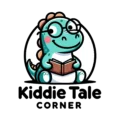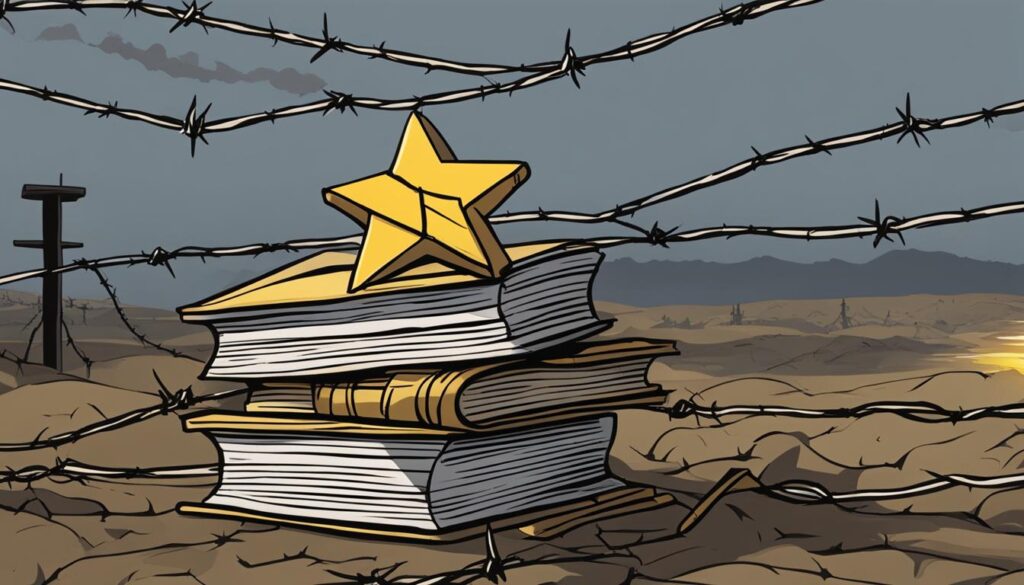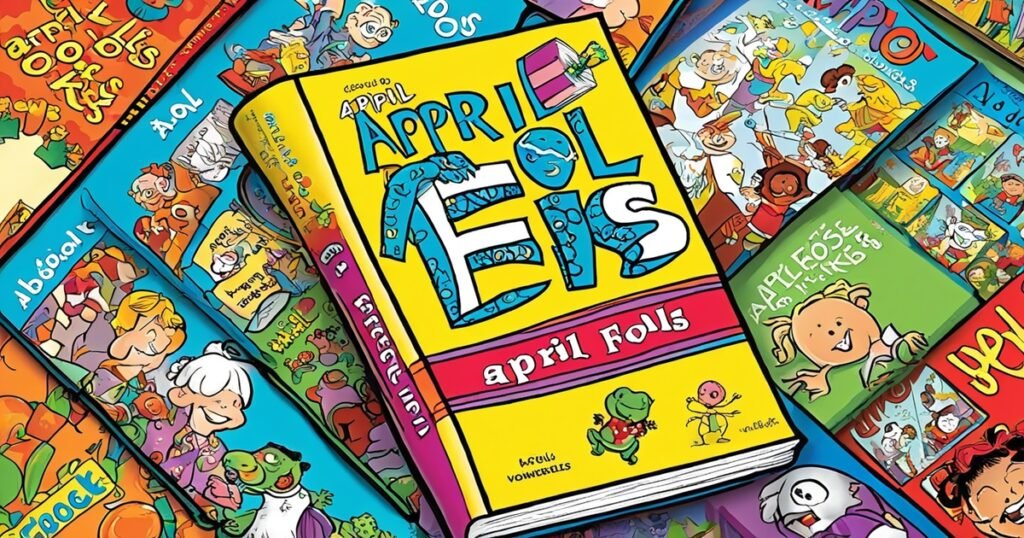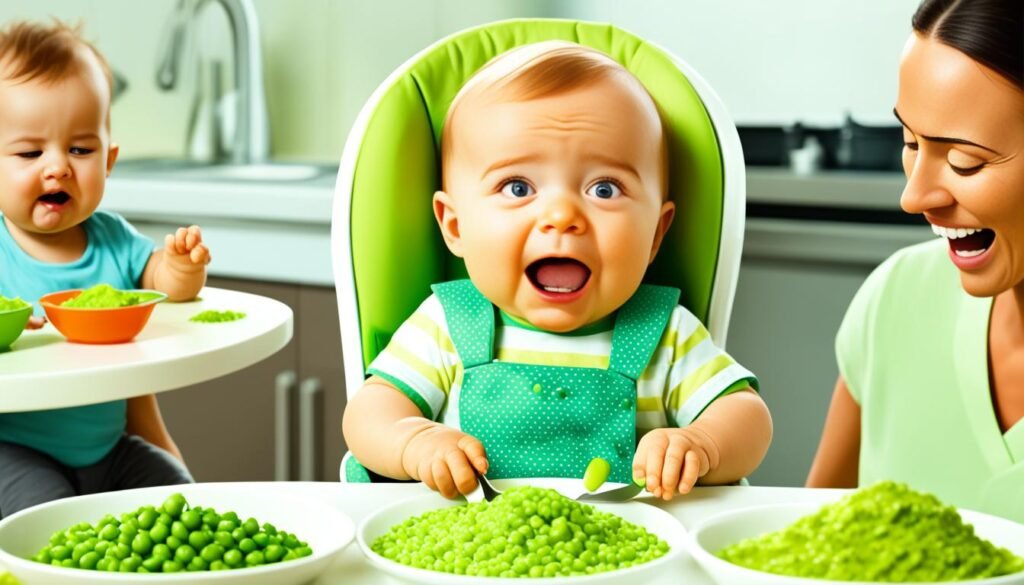Despite its heavy subject matter, the Holocaust remains a critical topic for middle school education. Young readers today often have significant knowledge gaps about this period, resulting in a lack of understanding and empathy. As a result, using age-appropriate Holocaust books for middle school students can be instrumental in integrating this part of history into their curricula. Incorporating quality, authentic literature into the study process not only helps educate, but also fosters empathy and understanding amongst young readers. This provides them a more profound personal connection to the past through the power of storytelling, countering the risk of historical unawareness.
Table of Contents
- Key Takeaways
- Understanding the Holocaust Through Literature
- Curating a Holocaust Bookshelf for Middle Schoolers
- Recognized Holocaust Books for Middle Schoolers
- Holocaust Books for Middle School with Impactful Narratives
- Incorporating Holocaust Education in Middle School Curriculum
- Biographical and Autobiographical Holocaust Accounts for Preteens
- Fiction Versus Non-fiction: Understanding the Role of Each in Holocaust Education
- Graphic Novels: A Unique Approach to Depicting Holocaust Stories
- Exploring Different Genres of Holocaust Literature for Middle School Students
- Conclusion
- Source Links
Key Takeaways
- Filling the knowledge gap about the Holocaust among middle school students is crucial.
- Using age-appropriate Holocaust books for middle school is an effective way to incorporate this history into their studies.
- Literature goes beyond just informing, fostering empathy and understanding.
- Stories provide a more profound, personal connection to past events.
- Utilizing high-quality, authentic stories can combat the risk of historical unawareness.
Understanding the Holocaust Through Literature
Holocaust education is a critical component of middle school curriculum, forming an integral part of a broader historical understanding. Amidst the typical confines of statistical facts and historical dates lie powerful narratives – accounts of extraordinary resilience that continue to echo across the decades. Harnessing the emotional depths and factual solidity of these narratives paves the way for teaching the Holocaust in middle schools, embracing its complexities rather than shying away from them.
Why Holocaust Education Matters
The place of Holocaust education in middle schools cannot be overstated. At a time when young minds are becoming more cognizant of the world’s complexities, understanding the atrocities of the Holocaust forms an essential building block in the broader historical narrative. Unfortunately, it’s noted that only 12 U.S. states currently mandate Holocaust education as part of their formal curriculum, leaving a significant gap in many students’ understanding. This makes literary resources, particularly those focused on the Holocaust, all the more critical in areas where structured lessons may be lacking.
Bringing History Alive with Storytelling
The horrors of the Holocaust will forever linger as a stark reminder of human cruelty. Yet, there is another side to it – one of extraordinary courage, resilience, and an unwavering spirit to survive. It is through these personal stories that an introduction to the Holocaust for middle school students becomes not only about conveying the facts but also about evoking empathy.
In the broad canvas that is Holocaust education for middle school, literature stands out as an invaluable tool. From vivid memoirs to gripping historical fiction, these stories make the distant past come alive. The characters we meet and the stories we learn from them leave a lasting impression, reminding us of the horrific events of the past and reiterating the significance of the slogan “Never Again.”
So, as we delve into the depths of history and remember the lives torn apart by the Holocaust, we also shed light on those forgotten stories of survival and resilience. Undeniably, Holocaust education is much more than teaching an event; it is about learning from our past to create a more understanding and empathetic future.
Curating a Holocaust Bookshelf for Middle Schoolers
When building a collection of Holocaust books for middle school students, the selections must strike a delicate balance—authentic enough to truthfully represent historical events, yet framed in a way that is appropriate for this age group. The spectrum of literature ranges from heartrending memoirs to compelling historical fiction, each providing a unique lens through which young learners can glean insights and connect with the people of this significant era.
Synthesizing a versatile bookshelf that includes various perspectives is instrumental in enhancing students’ comprehension. Such perspectives might originate from survivors, resistors, or average individuals caught in the midst of extraordinary circumstances. The varying voices foster a sense of humanity and solidarity among readers, making these children’s books about the Holocaust much more than just sources of information—they are catalysts for empathy and understanding.

Here, we’ve curated a selection of the best Holocaust books for middle school students. These titles were carefully selected to meet the aforementioned criteria—rigorously studied historical accuracy combined with engaging narratives suitable for a middle school audience.
- The Diary of a Young Girl by Anne Frank
- Number the Stars by Lois Lowry
- The Boy in the Striped Pyjamas by John Boyne
- Surviving the Angel of Death: The True Story of a Mengele Twin in Auschwitz by Eva Mozes Kor and Lisa Rojany Buccieri
- I Have Lived a Thousand Years: Growing Up in the Holocaust by Livia Bitton-Jackson
Each of these titles affords students the opportunity to see the Holocaust through the eyes of individuals of their own age bracket. Immersed in these stories, students are not just reading about history—they are personally connecting with it.
Recognized Holocaust Books for Middle Schoolers
Introducing middle schoolers to the Jewish experience through literature offers an emotionally connecting and educational approach. Certain books give a more resonating insight, especially those which have been felicitated at renowned platforms such as the Sydney Taylor Book Award. Let’s delve into the world of award-winning Holocaust literature for preteens that provides an authentic view of history.
Sydney Taylor Book Award Committee Selections
Since its inception in 1968, the Sydney Taylor Book Award has recognized over 200 Holocaust-related titles, representing both non-fiction and fiction that responsibly depicts Holocaust narratives. This prestigious award commemorates the notable instances of literature that present factual, compelling stories suitable for young readers.
Notable Books and Award Winners
Four noted selections that have been recognized by the Sydney Taylor Book Award committee are “The Boy on the Wooden Box,” “The Nazi Hunters,” “The Librarian of Auschwitz,” and “Beyond Courage.” Each of these titles deliver poignant narratives deeply infused with historical facts, making them among the best holocaust books for middle school readers. Let’s explore these significant works of literature in the table below.
| Title | Author | Genre | Short Description |
|---|---|---|---|
| The Boy on the Wooden Box | Leon Leyson | Biography | A stirring memoir of a young boy’s survival in the Holocaust as the youngest member on Schindler’s list. |
| The Nazi Hunters | Neal Bascomb | Non-Fiction | A true story about a band of secret agents, the hunt for Adolf Eichmann and bringing him to justice. |
| The Librarian of Auschwitz | Antonio Iturbe | Historical Fiction | Inspired by the experience of real-life Auschwitz prisoner Dita Kraus, it’s a tale of the courage to keep the hope of imagination alive, by protecting books. |
| Beyond Courage | Doreen Rappaport | Non-Fiction | A collection of extraordinary stories of Jewish people who sailed the dangerous waters and risked their lives to rescue others and fight the Nazis. |
These award-winning selections don’t just recount historical events, but also inspire empathy, resilience, and bravery among young readers, making them an essential part of the Holocaust literature in middle school curriculum.
Holocaust Books for Middle School with Impactful Narratives
One of the most vital functions of Holocaust books for middle school is their ability to tell powerful stories that stay with students, educating them on the historical events and moral lessons of the past. Select Holocaust literature provides the young reader with narrative depth, offering tales of survival, resilience, and hard truths under oppressive regimes.

- Resistance – A tale of strength and dedication in the face of adversity, this novel showcases the courage of youthful heroes who dared to stand against the oppressor.
- The Boy Who Dared – This stirring narrative provides a different take on the Holocaust, highlighting the bravery of a young man who defies Nazi laws to spread truth amidst falsehood.
- The Berlin Boxing Club – An evocative tale of a young Jewish boy navigating the complexities of approaching adulthood amidst the chaos of a city that no longer recognizes him as one of its own.
- Number the Stars – This poignant story paints a compelling picture of the life of a young girl witnessing the immense upheaval that surrounds her during the WWII period.
These books extend beyond the realm of mere historical fact. They delve into the realm of personal experiences and moral reflection, thereby fostering understanding and empathy. Reading such impactful narratives encourages students to step into the shoes of individuals from the past, understand their struggles, and gain a broader perspective on history. The implied lessons drawn from these Holocaust and WWII books for middle school students bear relevance even today, underpinning the importance of human values like courage, integrity, and empathy.
Incorporating Holocaust Education in Middle School Curriculum
Ensuring middle school students understand the gravity of the Holocaust without causing overwhelming distress is a balancing act of education. This highlights the importance of thoughtfully curated Holocaust curriculum for middle school, which achieves this balance through the careful selection of educational materials. A crucial factor in attaining this harmonization is picking age-appropriate books that can gently introduce students to the atrocities of the Holocaust while sparking their interest and understanding.
The Importance of Age-Appropriate Material
Finding age-appropriate books is vital to teaching the holocaust in middle school. As educators, we want our students to understand the depth of the historical event without causing significant emotional distress. Books such as “Hidden: A Child’s Story of the Holocaust” make use of graphical non-fiction to portray the Holocaust gently, making it suitable for this age group. Conversely, books like “I Have Lived a Thousand Years” offer a first-hand account of the event through a young protagonist’s viewpoint. This offers students the chance to put themselves into the shoes of those affected by the Holocaust, fostering a deeper understanding and connection to this significant period.
Recommended Books for Classroom Engagement
Aside from selecting age-appropriate literature, educators also have the responsibility to incorporate these books in ways that promote active classroom engagement. Providing an open forum for students to discuss the difficult themes within the text forms a supportive learning environment. Encouraging them to raise questions and share their thoughts can stimulate critical thinking skills. The following table details some recommended titles, along with their genre and brief description.
| Book Title | Genre | Description |
|---|---|---|
| “Hidden: A Child’s Story of the Holocaust” | Graphic Novel | A young girl learns about her grandmother’s experiences as a hidden Jewish child in Paris during the Holocaust. |
| “I Have Lived a Thousand Years” | Autobiography | A 13-year-old girl recounts her experiences in the Nazi concentration camps and her struggle for survival. |
| “The Diary of a Young Girl” | Autobiography | Anne Frank’s diary entries give eye-opening insight into the life of Jews hiding during the Holocaust. |
| “Number the Stars” | Historical Fiction | A tale of courage about a young girl helping her Jewish friend evade Nazis during World War II. |
Incorporating the Holocaust curriculum in a way that respects the emotional capabilities of middle school students while fostering an understanding of its significance is no small feat. With careful selection of literature and open, thoughtful discussion, students are given a powerful introduction to the holocaust.
Biographical and Autobiographical Holocaust Accounts for Preteens
When it comes to Holocaust education for middle school students, nothing connects them more directly to the past than biographical and autobiographical accounts. Such Holocaust books for middle school readers offer a valuable perspective into the lives of individuals profoundly affected by these historical events.
Autobiographical accounts, such as “The Boy on the Wooden Box” and biographical retellings like “Irena’s Children: Young Readers Edition”, let preteens review history through the eyes of those who lived it. These narratives introduce significant concepts like heroism, resistance, and survival in relatable ways. By bringing history up close and personal, these memoirs allow preteens to grasp the profound human impact of the Holocaust.

- “The Boy on the Wooden Box” – This autobiographical account of Leon Leyson, one of the youngest members to be saved by Oskar Schindler, provides a firsthand glimpse of survival and resilience.
- “Irena’s Children: Young Readers Edition” – This biography presents the tale of Irena Sendler, a social worker who saved 2,500 Jewish children during the Holocaust.
These books are excellent examples of age-appropriate Holocaust books for middle school students, combining deeply personal narratives with critical historical context.
| Title | Author | Type | Content |
|---|---|---|---|
| The Boy on the Wooden Box | Leon Leyson | Autobiography | A survivor’s story of resilience and survival during the Holocaust. |
| Irena’s Children: Young Readers Edition | Tilar J. Mazzeo and Mary Cronk Farrell | Biography | A tale of bravery showcasing how Irena Sendler saved 2,500 Jewish children. |
Fiction Versus Non-fiction: Understanding the Role of Each in Holocaust Education
When it comes to Holocaust education in middle schools, educators face the ongoing debate of incorporating fiction or non-fiction into their curriculum. Each genre plays an essential role in enlightening young readers about the Holocaust, providing different perspectives and insights into this momentous historical era.
Jewish Protagonists and Authentic Voices in Fiction
The power of fiction lies in its ability to humanize historical events by creating relatable characters and plausible narratives. Fictional Holocaust books for middle school like “What the Night Sings” and “The Berlin Boxing Club” offer narratives that feature Jewish protagonists, offering a window into the Jewish experience during the Holocaust. These stories can evocatively depict the struggles, resilience, and spirit of individuals during these times, fostering empathy among preteen readers.
The Power of Non-fiction in Relaying Historical Facts
On the other hand, non-fiction provides readers with factual accounts and a real-world view of the Holocaust. Books such as “The Boy Who Dared” and “Hitler Youth” present historical facts and authentic accounts, thereby accentuating the real-world implications of ideologies and actions during WWII. Besides broadening young readers’ knowledge about the Holocaust, non-fiction titles also develop critical thinking skills as students grapple with the interpretation and analysis of factual historical evidence.
Both genres hence serve as an effective pedagogical approach in the teaching of the Holocaust, each genre adding its unique value to inform, engage, and evoke reflection in young readers. The strategic selection and inclusion of both fiction and non-fiction Holocaust books for middle school not only broadens the scope of learning but also fosters a deeper and more nuanced understanding of the Holocaust.
Graphic Novels: A Unique Approach to Depicting Holocaust Stories
In the realm of Holocaust books for middle school, graphic novels have emerged as a compelling means of sharing poignant stories and significant historical events. Infused with authentic narratives that are intricately woven together, graphic novels engage young readers in a manner that is uniquely profound.
Visual Storytelling in Holocaust Education
The visual aspect of these books can help middle school students better understand and connect with the experiences depicted, providing a bridge for readers who might find traditional texts less engaging. This format can particularly resonate with visual learners and support the retention of historical information.
Noteworthy amongst graphic novels about the Holocaust is “White Bird: A Wonder Story” – a tale that employs powerful imagery to enhance the narrative and spark deeper emotional responses. Another remarkable example is “The Librarian of Auschwitz,” an exceptional portrayal of human compassion and perseverance amidst the harsh realities of the Holocaust.

Connecting with Young Readers through Graphic Novels
Graphic novels have the unique ability to capture the attention of middle school students, a demographic known to resonate with visual aids. These books not only educate but also promote empathy and awareness, vital sentiments that are transferable to their daily lives. Among the best Holocaust books for middle school, graphic novels stand out for their potent capacity to make history both accessible and impacting.
Whether as a part of the curriculum or independent reading, graphic novels offer a visually stimulating and engaging method for teaching middle school students about the Holocaust. In incorporating these novels into their reading lists, educators ensure that history reaches their pupils in the most effective and meaningful of ways.
Exploring Different Genres of Holocaust Literature for Middle School Students
The breadth of Holocaust books for middle school students extends across various genres, each offering a unique lens into this historical era. The richness and diversity of these literary forms allow nuanced exploration of themes related to the Holocaust, supporting deeper understanding, reflection, and empathy among young readers.
In the realm of realism, novels such as “Milkweed” depict the gritty truth of life during WWII. The honesty and poignancy of such stories provide readers with an understanding of the harsh realities faced by individuals during the Holocaust. Equally engaging are books rich in psychological depth, such as “The Book Thief”. Thesestories unravel the complex emotional landscapes of characters, promoting critical thinking and emotional intelligence among middle school students.

The non-fiction genre offers an immersive glimpse into the history of the Holocaust, lending authenticity to school curriculums. Titles such as “I Have Lived a Thousand Years” showcase astounding resilience in the face of unimaginable horrors, encouraging readers to delve into the lives of survivors and glean a realistic perception of the circumstances surrounding the Holocaust.
Graphic novels like “Anne Frank’s Diary: The Graphic Adaptation,” with its compelling visual narratives, and action-packed books like “Project 1065” also provide exciting alternative literature formats that cater to different reading preferences.
Exploring these diverse genres helps to assure that all middle school students can find a pathway into this critical period of history, and can further engage with and refine their understanding of the Holocaust.
| Genre | Book Title |
|---|---|
| Realistic Fiction | “Milkweed” |
| Psychological | “The Book Thief” |
| Non-Fiction | “I Have Lived a Thousand Years” |
| Graphic Novel | “Anne Frank’s Diary: The Graphic Adaptation” |
| Action-Packed Fiction | “Project 1065” |
Conclusion
In the realm of Holocaust education for middle school students, literature plays an overarching role. The carefully selected, age-appropriate Holocaust books for middle school culminate to form a grand narrative that extends far beyond the bounds of the conventional classroom scenario. From memoirs and autobiographies to fiction and non-fiction accounts, these meticulously curated books serve to pave an educational path that, while rooted in the past, resonates powerfully in the mind of the contemporary youth.
Encouraging Empathy and Education Through Reading
Each book carries with it a potent mix of personal stories and intense survival tales that beckon young readers to delve deeper into their understanding of the Holocaust. This process is reflective, as these books summon forth feelings of empathy and initiate critical thought processes. The underlying theme is not just the factual details of history, but resounding accounts of the indomitable human spirit that engulf young minds in thoughts of survival, resistance, and resilience.
The Lasting Impact of Holocaust Literature on Young Minds
The narratives in best Holocaust books for middle school students leave an indelible imprint on their minds. The emotional depth and educational breadth of these books foster awareness that transcends the classroom. By amplifying empathy and the unyielding spirit of man, these pieces of literature are far-reaching in their effect. They shape the minds of the young, transforming them into informed, compassionate individuals, contributing to a future generation that reminisces the past to shape a better tomorrow.
FAQ
Why is Holocaust education important for middle school students?
Holocaust education is crucial in middle school as this is a formative stage where students begin to understand the complex facets of history. Literature serves to inform and foster empathy, providing a more profound personal connection to the distant past through storytelling. It helps fill the significant knowledge gaps among young readers about the Holocaust and emphasizes the mantra “Never Again”.
How can age-appropriate Holocaust books be selected for middle schoolers?
Selecting age-appropriate Holocaust books for middle schoolers requires a balance of accurate historical information and age-appropriate storytelling. Books can range from memoirs to historical fiction, each providing a unique lens through which students can learn and feel connected. A combination of different perspectives enriches students’ comprehension and cultivates a sense of humanity and solidarity.
What does a Holocaust bookshelf for middle schoolers include?
A Holocaust bookshelf for middle school students should include various perspectives, such as those of survivors, resistors, and ordinary individuals caught in extraordinary circumstances. The selection should also include works that have received recognition through awards like the Sydney Taylor Book Award, which recognizes fiction and non-fiction that responsibly yet engagingly depict Holocaust narratives.
How can the Holocaust be taught through biographical and autobiographical accounts?
Biographical and autobiographical accounts offer preteens a direct connection to personal experiences from the Holocaust. They give middle school students insight into the real stories of individuals who displayed remarkable bravery and resilience. These accounts provide not just historical context but also introduce concepts of heroism, resistance, and survival.
Why is the use of fiction and non-fiction important in teaching the Holocaust?
Fictional accounts offer narratives with Jewish protagonists, providing an empathetic portrayal of the Jewish experience during the Holocaust. Non-fiction titles present historical facts and genuine accounts that underscore the real-world implications of ideologies and actions during WWII. The use of both genres serves to inform, engage, and evoke reflection among middle school readers.
What role do graphic novels play in Holocaust education?
Graphic novels visually convey Holocaust stories and historical events, enhancing the narrative and evoking deeper emotional responses. They serve as a powerful medium in Holocaust education, helping middle school students better understand and connect with the experiences depicted, particularly resonating with visual learners.
Why is it necessary to explore different genres in Holocaust literature for middle school students?
Exploring different genres in Holocaust literature allows students to experience the historical period through multiple narrative forms. A diverse range of genres provides a broader understanding and reflection on the themes of the Holocaust. This approach ensures that there is an entry point for every middle school reader into this critical era of history.



